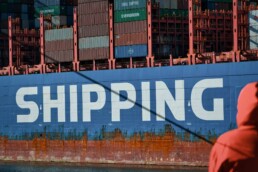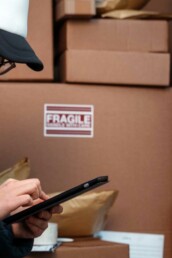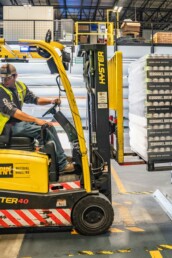The Future of Supply Chains: What's Coming Next in Logistics
The Future of Supply Chains: What’s Coming Next in Logistics Management
The landscape of supply chain management changes nearly every day. Global events, new technologies, shifts in consumer demand, and increased focus on sustainability continuously impact how products move from point A to point B. For third-party logistics providers (3PLs), staying on top of these developments is critical to remaining competitive and providing excellent Freight Forwarding, Warehousing and Distribution, and Fulfillment Services to clients.
So what’s on the horizon for 3PLs? Here are three key areas to pay attention to when preparing your Order Fulfillment Solutions and overall supply chain strategy for the coming years.
Embracing New Technologies

One major shift occurring in the future of supply chains is the integration of new technologies like artificial intelligence, machine learning, robotics, and more. As these innovations enable increased Warehouse Automation and higher efficiency, 3PLs need to determine how to best leverage them. For example, autonomous mobile robots can drastically improve productivity in fulfillment centers while also providing scalability to meet changing demands. 3PL Technology Solutions like transportation management systems (TMS) and cloud-based warehouse management systems (WMS) also bring opportunities to enhance visibility, reporting, optimization, and automation across supply chain activities.
Essentially, new technologies allow 3PLs to do more with less while also reacting faster to client needs and global events. However, implementation takes careful planning regarding integration requirements, change management, and how tech tools best support current Warehouse and Distribution processes. Additionally, as new innovations emerge, 3PLs must stay actively aware and be ready to evolve their capabilities.
Prioritizing Agility and Flexibility
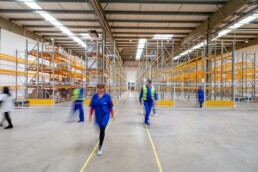
With climate change and environmental impact becoming increasingly important to consumers, businesses must address sustainability across their operations. 3PLs are no exception, as many of their enterprise clients have made public commitments to reduce waste, emissions, and other areas. As a result, sustainability will become a key consideration and potential differentiating factor for many shippers when selecting Supply Chain partners.
Some important areas 3PLs should evaluate from a sustainability perspective include Packaging Optimization, evaluating energy sources in Warehousing operations, Investment in more fuel-efficient fleets, and providing transparency into emissions data tied to Shipping and Delivery. Building a Fulfillment Center certified through sustainability organizations like the EPA’s SmartWay Transport Partnership also signals dedication. Offering Reverse Logistics and re-commerce services allows reuse of materials, further reducing waste sent to landfills.
Essentially, all aspects of 3PL operations present opportunities to become better environmental stewards. Getting ahead in developing company-wide sustainability goals and measurable improvement plans will pay dividends with both new and existing clients.
Focusing on Sustainability
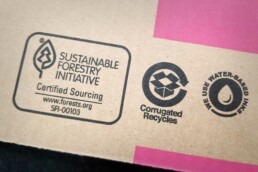
The future of supply chains has been changing in recent years, unforeseen disruptions like the COVID-19 pandemic and various geopolitical conflicts have highlighted the need for resilient, agile supply chains. As a result, businesses are looking to partners like 3PLs to help implement solutions that mitigate risk and adapt swiftly when the unexpected occurs.
Some ways 3PLs can build flexibility include expanding their Carrier Selection to have contingency plans when certain channels become unavailable. Diversifying Warehousing and Distribution across different geographic regions also limits exposure when localized disruptions occur. Additionally, strong relationships with suppliers allow 3PLs to stay aware of Inventory issues upstream and respond appropriately.
Ultimately, the 3PLs best positioned for long-term success will be those viewing adaptability and resilience as competitive advantages. Investment in infrastructure, technology, carrier partnerships, and inventory strategies is required to create responsive, customizable Order Fulfillment Solutions ready to handle whatever comes next.
Beginner’s Guide to Third-Party Logistics (3PL)
The world of e-commerce is always changing, understanding the roll of Third-Party Logistics is integral to keeping up. This beginner’s guide to third-party logistics (3PL) will delve into the essential aspects, offering insights into fulfillment services, warehousing, and much more.
Read More…
E-commerce businesses partnering with 3PLs must recognize the efects of adaptability, innovation, and sustainability in the future of supply chains. As disruptions, technological advancements, and sustainability imperatives reshape the logistics sphere, the onus falls on businesses to collaborate with 3PLs adept at embracing new technologies, prioritizing sustainable practices, and fortifying resilience. By investing in forward-looking strategies, harnessing robust technology solutions, and championing sustainability initiatives, e-commerce ventures stand to benefit from resilient and agile supply chains. These forward-thinking approaches not only fortify partnerships with 3PLs but also ensure readiness in navigating the dynamic challenges that lie ahead, fostering growth and success in the ever-evolving e-commerce ecosystem.”
Falcon Fulfillment focuses on these supply chain struggles and can help you keep your competitive edge.
Let’s Talk!
Consumer Trends That Impact Order Fulfillment
Consumer trends that will impact order fulfillment.
The consumer landscape is constantly changing, with new trends emerging every year. Consumer expectations continue to rise, spending is cooling due to inflation, and supply chains still have issues affecting orders. As we enter this next year, it’s vital to stay ahead of the curve and anticipate the impact that recent consumer trends will have on order fulfillment. Here are some consumer trends we can expect this year that could significantly alter how goods are delivered to customers.

1. Increased Automation
Automation technologies are becoming increasingly sophisticated, allowing companies to streamline their order fulfillment processes and reduce costs. Automation can enable companies to process orders quickly and accurately track shipment status, improving customer satisfaction. Repetitive tasks like demand planning, carrier selection, and order assignments are completed automatically using high-tech software systems. Here are a few high-level examples of areas where automation can be most helpful in the order fulfillment process.
- Data and Systems Integration – integrated systems make real-time tracking, inventory levels, and reporting possible.
- Carrier Selection – Use order fulfillment programs to select a carrier based on chosen criteria. Each carrier offers different rates, delivery speeds, and services for each order. Businesses must determine a carrier balancing cost against speed or service types to maximize customer satisfaction. Doing this manually becomes overwhelming as sales increase. Automating this selection speeds up fulfillment speed and accuracy and often saves money. Furthermore, the criteria for shipping can be set by the consumer, which improves customer personalization and satisfaction.
- Demand Forecasting – Forecasting analyzes historical data to anticipate customers’ willingness to purchase products and services. It is a way of ensuring adequate stock quantities to avoid stockouts and limit overstocking. Automating this process using AI has had significantly higher accuracy that helps streamline supply chain issues and hit the sweet spot of product supply and demand.
- Inventory Planning – Automating inventory planning is linked to demand forecasting but also includes ensuring adequate warehousing is available, tracking real-time supply levels, and integrating inventory systems with omnichannel sales systems. Furthermore, as orders are fulfilled, inventory planning systems will initiate auto-reorders and order delays as stock runs low.

2. On-Demand Delivery
As a result of this trend toward faster, more convenient delivery, there could be an increase in on-demand services, allowing quicker, easier receipt of goods. In fact, this consumer trend impacts order fulfillment more than any other. Therefore, companies must develop strategies to meet demand and ensure reliable, cost-effective delivery. For example, they may need to optimize routes, expand fulfillment centers, utilize automation, and leverage AI to predict orders. Ultimately, companies that fulfill fastest while providing a smooth customer experience will likely gain an advantage. By preparing for this shift toward on-time delivery now, retailers can exceed expectations and thrive.
The biggest challenge retailers will face is providing faster delivery without adding high costs. Many businesses are offering conditional free shipping options to meet on-demand delivery expectations. These might include a free shipping purchase threshold, offering it for particular items or products, or for a limited time. Additional strategies include delivery alternatives like BOPIS (buy online, pick up in-store) and local delivery. Creativity is required to keep customers happy and maintain healthy margins.

3. Greater Personalization
Customers increasingly expect personalized experiences from purchases. As a result, companies must personalize their products and services to meet customer expectations. For instance, this could include customizing packaging and delivery services based on customer preferences. In addition, consumers are influenced by brand ambassadors sharing unboxing experiences. Therefore, companies should consider leveraging unboxing videos and social media influencers to showcase personalized unboxing events. Ultimately, as personalization becomes more attainable through technology, companies should take advantage of opportunities to tailor products, services, and experiences to each customer’s unique preferences. By doing so, they can hope to create deeper brand affinity and engagement through every personalized touchpoint.
Elements of personalized and memorable unboxing experiences:
- Branded packaging – Even if the outer box is traditional, the inner box, as well as every component of the packaging material, should reflect your brand identity
- Create a story with the unboxing – consider how you can take the customer on a journey from opening to unwrapping their product
- Include handwritten notes
- Include personalized discount codes and product add-on suggestions
- Encourage social shares of their experience and thoughts about your products

4. Increased Use of Technology
Here is the passage with some added transition words:
In the coming years, we can expect to see an increase in the use of technology to improve order fulfillment. For example, this could include using AI-assisted robots to pick, pack, and ship orders and automated warehousing systems to ensure accurate and efficient order fulfillment. In fact, some retail giants already see improved outcomes from using AI-powered bots. Furthermore, as technology continues to advance, we will likely see even more sophisticated systems for streamlining the order fulfillment process from start to finish. Whether it’s through advanced robotics, predictive analytics, or other innovations, the goal will be to deliver orders to customers as quickly and seamlessly as possible. Overall, the next decade promises exciting progress when it comes to leveraging technology to transform warehouse operations and order fulfillment.
The robots receive shipments and deliver them to staff, who scan items into the system. Using high-tech AI computer vision, another program uses color-coded lights to show the team where to store items. Our natural human intuition tends to place similar items next to one another. In contrast, technology has shown that using “random stow” (which means inventory bins store a variety of items – books next to sports equipment next to toys, for example) reduces errors during the picking process. This is just one of the ways that technology will continue to change how order fulfillment is accomplished.
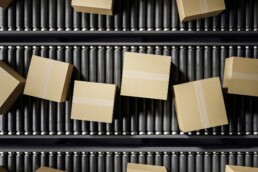
5. Partnering with a Tech-Forward 3PL
Tech-forward 3PLs are implementing most of the above trends. Many fulfillment companies have already adopted automation systems to reduce overhead, inefficiencies, and staffing needs. Furthermore, a solid 3PL will provide a broader network of carriers, lower overall shipping costs, and faster delivery. Lastly, a partnership with a 3PL can afford your business a much higher level of technology without purchasing expensive systems in-house.
The Impact of Shipping and Delivery on E-commerce Satisfaction
In the evolving world of e-commerce, customer satisfaction hinges not only on product quality and price but also on the efficiency and reliability of shipping and delivery services. Understanding the significance of these factors is crucial in enticing potential e-commerce leads. In this blog, we delve into the key takeaways from a recent survey regarding shipping and delivery experiences, and how these findings can shape your approach to enticing e-commerce businesses.
Future consumer trends will have a significant impact on order fulfillment. Companies must be prepared to implement and adapt their strategies to stay ahead of the competition and provide customers with a seamless and enjoyable experience. By anticipating these trends and taking the necessary steps to prepare, companies can ensure that their order fulfillment processes are ready for the future.
If you are curious about how partnering with a 3PL can help your business implement these trends, get in touch with one of our agents today.
Let’s Talk!
Help Your E-commerce Save Money With A 3PL
Help Your E-commerce Save Money with a 3PL
Wanting to own your own time is a common reason why people decide to launch their own businesses. They want to be the master of their own schedule. However, many business owners quickly realize that when you launch an e-commerce it can eventually begin to own you. Two of the largest and most critical elements of any e-commerce are shipping and fulfillment. Doing it yourself in-house can save you some money in the short term but it could hinder your growth in the long run. Let’s walk through a few ways your e-commerce can save money with a 3PL.
Warehousing
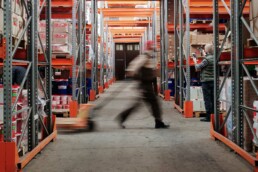
Whether you rent or own warehousing facilities, you will need to stage, store, and ship goods. If you own your warehouse, do you have space to expand when necessary or beneficial? If you rent warehouse space, do you have flexible options to meet fluctuating demands? The accuracy of your sales projections will determine if you’re in the sweet spot of warehousing, or whether you need to look for more financially-savvy options.
Alternatively, when you’re partnered with a 3PL, you have the flexibility and freedom to scale when you need to – and when you want to. Furthermore, a 3PL partner offers scalability options without the long-term commitments you would encounter otherwise. This cost savings and flexibility allow e-commerce to maximize sales and scale readily.
Staff
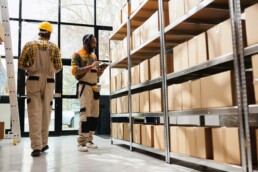
Depending on the size and quantity of your products, you will likely need a few extra hands to get them to your buyers. If you are managing in-house fulfillment, you are 100% responsible for hiring, quality control, management, and down-sizing when necessary. If you have an employee walkout mid-shift, guess who is still on the hook to get orders out the door? Yep, it’s you. With a 3PL partner, you are free to run as many product promotions, launches, and sales collaborations as you can, without the risks of personal staff or process delays. A 3PL manages all the personnel required to scale up or down as your e-commerce needs change.
Packaging

No matter what you are shipping, it must be packaged. As a solopreneur, you will likely run into MOQ (minimum order quantities) on packaging materials. This includes; boxes, filler, bags, and more. Depending on the upfront investment cost, it could limit the number of products you are able to deliver in one shipment. If you sell more than one type of product, it further complicates your packaging spend. With a 3PL partner, you are afforded much higher flexibility in packaging services due to the high volume of products purchased and strategic packaging vendor relationships leveraged by most 3PL’s. In addition, depending on the 3PL partner, they can offer personalized packaging which elevates your brand awareness and visibility.
Shipping

The least expensive way to ship most products is to do it yourself. You pick it, pack it, wrap it, drive it to the shipping location, and update the customer with the delivery details. Then you monitor tracking to ensure it makes it to the customer. Even though a 3PL partner will not necessarily lower your shipping costs, it will alleviate the cost of time. You no longer will be working IN the business but ON it. A quality 3PL will not only get your product shipped in a timely manner, they will also have an inventory management system that will inform you and the customer of the delivery status.
Returns
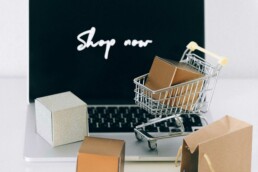
Every e-commerce will have to manage returns and the average percentage for e-commerce hovers between 20-30%. This isn’t a big deal if you are processing 5 orders or less per day. However, just beyond this threshold is a tsunami of returns that threatens to slow down the processing of future orders. Working with a 3PL gives you the peace of mind that returns will be received, reshelved, and reshipped when an exchange is desired. Furthermore, 3PL’s that have invested in high-tech IMS will be able to keep more accurate quantities so that you don’t miss out on sales of products that simply haven’t been added back as available inventory.
Beginner’s Guide to Third-Party Logistics (3PL)
The world of e-commerce is always changing, therefore understanding the roll of Third-Party Logistics is integral to keeping up. In light of this our beginner’s guide to third-party logistics (3PL) will delve into the essential aspects, offering insights into fulfillment services, warehousing, and much more.
Read More…
Partnering with a 3PL will save you money by giving your company the flexibility in warehousing, staffing, and packaging. It will save you time, hassle, and headaches by alleviating shipping burdens, inventory management, and dealing with returns. While the immediate costs may appear to be higher, a good 3PL partner will help lay the foundation for the next stage of your e-commerce growth and save you money in the long run.
If you want to own your time again, get in touch with one of our agents. See how Falcon Fulfillment can help you regain life’s most precious commodity.
Let’s Talk!
The Importance of Contract Manufacturing Partners in E-commerce
The Importance of Key Contract Manufacturing Partners in E-commerce – Spotlight on Fulfillment
E-commerce is booming. As an online seller, you need to ensure your production and shipping operations can keep up with demand. This makes choosing the right contract manufacturing and third-party logistics (3PL) partners essential. These key partners serve as extensions of your business, significantly impacting order fulfillment accuracy, speed, costs, and ultimately, profitability.
The Critical Role of Partners in E-commerce Success

With the rise in consumer expectations for faster deliveries, businesses face an imperative need for scalable solutions to fulfill orders promptly and efficiently. Consequently, leveraging an experienced 3PL provider becomes paramount for e-commerce companies to meet customer demands while optimizing their supply chain operations. From warehousing and inventory management to shipping and delivery, entrusting these crucial activities to a specialist allows you to focus on your core business initiatives.
Furthermore, partnering with a reliable contract manufacturer seamlessly streamlines production planning and management. As you scale up inventory to align with burgeoning sales volumes, the right manufacturing partner guarantees on-time production runs and maintains consistent product quality.
In this blog, we delve into why contract manufacturing and 3PL partners stand as indispensable allies for e-commerce ventures and shed light on essential considerations when selecting these pivotal partners.
Seamless E-commerce Order Fulfillment
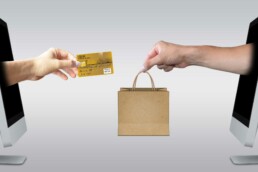
E-commerce order fulfillment can get chaotic, especially during peak sale seasons like Black Friday and Cyber Monday. You have to grapple with accurately forecasting consumer demand, mobilizing inventory, picking and packing orders meticulously, and coordinating deliveries through multiple shipping carriers.
This entire process needs to happen quickly and efficiently so customers get their purchases on time. A minor hiccup anywhere in the sequence can result in delayed shipments and poor customer experiences.
By partnering with a 3PL provider, e-commerce sellers can outsource core supply chain functions for greater operational efficiency. A 3PL leverages its warehousing infrastructure, trained staff, shipping carrier relationships, and logistics technology to provide complete order fulfillment solutions. This includes services such as:
- Inventory Storage and Management: 3PLs provide secure warehouse space to store your inventory while handling ongoing inventory management involving tracking stock levels, optimizing storage locations, and cycle counts for accuracy.
- Order Processing and Fulfillment: When you receive an order, the 3PL picks, packs, and ships your customer’s purchase. This includes essential activities like custom kitting and packaging along with attaching invoices, marketing collaterals, and return labels in the box.
- Shipping and Delivery: With its relationships with all major shipping carriers, a 3PL coordinates quick, reliable deliveries. The provider can even handle last-mile delivery in some cases. You get access to volume-based shipping discounts, reducing fulfillment costs.
- Reverse Logistics: A 3PL also manages product returns, repairs, and refunds through streamlined RMA workflows. The provider inspects returned inventory, initiates refunds or replacements, and restores items to saleable condition. This closes the loop on the post-purchase experience.
With these modular solutions, 3PL providers empower e-commerce retailers to scale order fulfillment capabilities on-demand.
Ramping Up Inventory Production

For e-commerce businesses that manufacture their own products, production planning and inventory management are crucial but challenging. As your brand gains traction, you have to rapidly increase manufacturing runs to prevent stockouts without overstocking. This requires working with a flexible, reliable contract manufacturing partner.
A contract manufacturer essentially serves as an extension of your production team. The partner handles activities like procuring raw materials, manufacturing goods based on your specifications, performing quality assurance checks, and supporting new product development.
This arrangement helps e-commerce sellers focus internal bandwidth on high-level supply chain planning while leaving execution to specialists.
Benefits include:
- Cost Efficiencies: Contract manufacturers develop expertise related to your type of product, comparatively streamlining processes over time. Also, their economies of scale and access to lower material costs then lower per unit production costs.
- Production Scalability: You can rapidly scale up or down production runs based on sales projections. This prevents losses from overstocking while ensuring adequate inventory is on-hand.
- Improved Quality: With dedicated factory supervision, contract manufacturers ensure each product batch meets your specifications around materials, dimensions, finishes, and functional performance.
- Faster Speed to Market: For launching new products, a contract manufacturing partner handles activities like prototype development, testing iterations, securing regulatory compliance, and refining manufacturing processes to get your innovation to market faster.
By leveraging external specialists for manufacturing and shipping, e-commerce businesses can better react to consumer demand fluctuations.
Choosing the Right Partners

With contract manufacturing and 3PL partnerships playing such a crucial role in e-commerce operations, you need to vet potential partners thoroughly.
Start by checking basics like years in business, clientele, locations, and service capabilities. More importantly, assess prospective partners across parameters like:
- Reliability: Manufacturing and shipping timelines directly impact order fulfillment so reliability is key. Review on-time delivery rates and client testimonials related to responsiveness.
- Scalability: As your business grows, you need partners equipped to scale alongside you. Evaluate capacity limits for production, storage space, picking and packing bandwidth, etc.
- Technology: Manufacturing and logistics technologies ranging from production monitoring software to warehouse management systems and shipment tracking tools can optimize complex workflows. Verify partners utilize solutions that provide visibility and drive continuous improvement.
- Cost Structures: The financial viability of your e-commerce operations depends greatly on production and fulfillment costs. Compare pricing models across potential partners to find the best fit based on your volume and cash flow availability.
- Customer Service: Order issues inevitably arise so responsive, resolute customer service is non-negotiable. Assess communication cadences, response times, language support, and other service parameters.
By thoroughly evaluating partners against these criteria and more, you can select players that become invaluable allies as you grow your business.
The Power of Partnerships
E-commerce success ultimately boils down to your ability to meet customer demand, whenever and wherever it arises. This requires supply chain agility that can only be achieved through partnerships with contract manufacturing and logistics specialists.
Beginner’s Guide to Third-Party Logistics (3PL)
The world of e-commerce is always changing, understanding the roll of Third-Party Logistics is integral to keeping up. This beginner’s guide to third-party logistics (3PL) will delve into the essential aspects, offering insights into fulfillment services, warehousing, and much more.
Read More…
Outsource production and fulfillment, especially with providers equipped to flex as your operations scale. This allows you to stay laser focused on sales, marketing, and business expansion efforts.
With robust behind-the-scenes support, your e-commerce venture is primed to flourish.
Let’s Talk!
Expedited vs. Standard Shipping: Making the Right Choice
Expedited vs. Standard Shipping: Making the Right Choice for Your Business
The speed at which goods reach customers is pivotal. Moreover, the shipping process profoundly influences customer satisfaction and a company’s profitability. When faced with the choice between expedited vs. standard shipping, businesses encounter crucial decisions that impact their bottom line and customer experience.
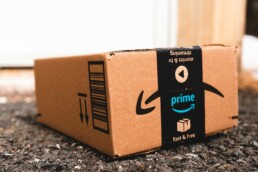
Understanding Expedited Shipping
Expedited shipping, characterized by rapid delivery, offers customers shorter transit times, spanning from 1-3 days, overnight, or even same-day delivery. Additionally, while ensuring priority handling and tracking capabilities, it comes at a higher cost due to expedited transit options such as air freight or specialized delivery methods. Nevertheless, despite the expense, expedited shipping offers several advantages:
Why Opt for Expedited Shipping?
Enhanced Customer Satisfaction:
By bridging the gap between online and offline shopping experiences, expedited shipping elevates customer satisfaction, fostering loyalty and repeat purchases.
Competitive Edge:
It sets businesses apart by providing swift delivery, making the brand more appealing to consumers in a crowded eCommerce landscape.
Urgent Order Fulfillment:
Ideal for time-sensitive orders, expedited shipping caters to immediate needs, ensuring prompt service.
Drawbacks of Expedited Shipping
Increased Operational Costs:
The swift pace of expedited shipping relies on expensive transportation methods, potentially affecting profit margins or deterring customers due to added expenses.
Geographical Limitations:
Not universally accessible, especially in remote areas, which can tarnish brand image and cause delays in international shipping due to complex customs procedures.
Standard Shipping: A Practical Approach
Standard shipping, the conventional choice, lacks the swiftness of expedited delivery but remains cost-effective and widely accessible. Despite its slower pace, it presents customers with a predetermined cost and arrival date, typically taking 5-8 business days domestically.
Why Opt for Standard Shipping?
Cost-Effectiveness:
Appeals to budget-conscious customers due to its affordability, fostering positive connections with the company.
Wider Geographic Reach:
More accessible and feasible for remote locations, widening the customer base and fostering inclusivity.
Suitability for Non-Urgent Orders:
Perfect for items where immediate delivery isn’t a priority, providing a practical solution for less time-sensitive purchases.
Drawbacks of Standard Shipping
Extended Delivery Times:
Risks alienating customers expecting quicker service, potentially resulting in negative reviews and lost sales.
Not Suitable for Urgent Orders:
Falls short for time-sensitive purchases, impacting customer satisfaction and hindering last-minute purchases.
Choosing the Right Shipping Method
Expedited Shipping Is Ideal When:
- Dealing with time-sensitive or high-value items.
- Catering to urgent or emergency orders.
- Targeting premium customers valuing prompt delivery.
Standard Shipping Is Suitable When:
- Selling non-urgent goods like home decor or books.
- Targeting cost-conscious customers.
- Managing predictable orders such as subscription boxes.
Navigating Shipping Choices
The choice between expedited and standard shipping hinges on several factors: the nature of the products, urgency levels, geographic reach, and the target audience. Balancing these considerations ensures a broader appeal to potential customers, meets their expectations, and maximizes sales potential.
A crucial aspect often overlooked in this dichotomy is the ability to merge both expedited and standard shipping services, thereby offering a broader spectrum of choices to customers.
Embracing a Hybrid Approach: Merging Expedited and Standard Shipping
By integrating expedited and standard shipping options into a hybrid approach, businesses unlock a more comprehensive suite of choices for their customers. This approach, complemented by transparent communication and customer-centric strategies, can significantly impact customer satisfaction and overall business performance.
Advantages of a Hybrid Shipping Model
Enhanced Customer Satisfaction:
A hybrid shipping model caters to a wider range of customer preferences, catering to both the urgent needs of some customers and the cost-consciousness of others.
Maximized Sales Potential:
By offering diverse shipping options, businesses increase the likelihood of completing sales from a broader customer base.
Competitive Advantage:
Standing out in the competitive eCommerce landscape becomes feasible by offering flexibility and meeting diverse customer expectations.
Implementing a Hybrid Shipping Strategy
Transparent Shipping Information:
Clearly communicate shipping options, delivery estimates, and associated costs during the purchasing process to avoid customer dissatisfaction and cart abandonment.
Flexible Pricing Structures:
Incorporate tiered pricing for expedited shipping options and consider offering free standard shipping above a certain order threshold to encourage larger purchases.
Utilizing Technology:
Leverage sophisticated shipping software to streamline the management of both expedited and standard shipping, optimizing efficiency and cost-effectiveness.
Customer-Centric Approach: The Key to Successful Shipping Strategies
A customer-centric approach is the cornerstone of a successful shipping strategy. Understanding and meeting customer expectations play a pivotal role in ensuring satisfaction and retention.
Elements of a Customer-Centric Approach
Proactive Communication:
Provide timely updates about order status, shipping timelines, and any potential delays, keeping customers informed and engaged.
Personalized Options:
Offer customers the ability to choose their preferred shipping method based on their urgency and budget constraints.
Feedback and Adaptation:
Continuously gather customer feedback to identify areas for improvement and adapt shipping strategies accordingly.
Beginner’s Guide to Third-Party Logistics (3PL)
The world of e-commerce is always changing, understanding the roll of Third-Party Logistics is integral to keeping up. This beginner’s guide to third-party logistics (3PL) will delve into the essential aspects, offering insights into fulfillment services, warehousing, and much more.
Read More…
Nurturing Customer Relationships through Shipping
The choice between expedited vs. standard shipping is not a binary decision. Instead, it involves a nuanced understanding of customer needs, business goals, and market dynamics. A hybrid approach that seamlessly merges expedited and standard shipping services, coupled with a customer-centric strategy, stands poised to deliver higher customer satisfaction, increased sales, and a competitive edge in the ever-evolving eCommerce landscape.
Remember, the success of a shipping strategy lies in its ability to accommodate varying customer preferences while ensuring timely, cost-effective, and reliable delivery services.
Looking for more information about your options and what is right for your business? Talk to a Falcon professional and we will help set you up for success!
Let’s Talk!
Working with Falcon Fulfillment
The Goal: A 3PL That Goes Beyond a Partnership
If you’re browsing through third-party logistic companies, chances are, you’re looking for a fulfillment partner. A typical 3PL partnership consists of a third party handling the order fulfillment sector of your business. With most popular 3PL companies – that’s all you ever get.
While we still deliver quality fulfillment services, the focus of Falcon is a partnership that goes beyond the normal expectations of a fulfillment partner.
We’re interested in the success of your company – even when it’s not with us.
We understand that your business needs experts in multiple fields, not just logistics. That’s why our partners have exclusive access to our personal network of experts, in various sectors of e-commerce including manufacturing, operations, marketing, IT, and more.
If we don’t specialize in it, we’ll connect you with someone who does.
Alongside customized sustainable packaging, competitive accuracy rates, and dedicated account managers, our array of industry connections is one of the many reasons our clients choose to partner with us.
When working with Falcon, our onboarding process is designed to give you personalized service tailored toward the aspects your e-commerce needs and demands. Once we establish priorities we connect to our API and begin streamlining your orders within a couple of days or weeks – never months. Switching your 3PL fulfillment partner has never been easier.
“By providing our clients more flexibility around onboarding, it allows them to easily facilitate the implementation transition with their vendors & suppliers as well as IT management & customer support teams. Additionally, providing them the ability to better manage any unexpected disruptions or delays along the way.”
Corinne Mathieson, Senior Account Manager
When searching for the right fulfillment partner, it can be confusing, time-consuming, and even daunting. That’s why we’ve outlined precisely what it’s like to partner with us, what you can expect, and what our onboarding process consists of. With this step-by-step onboarding guide, we help eliminate confusion, second thoughts, and blind spots.

Phase One: Introduction
The introductory stage with Falcon Fulfillment consists of representatives from both companies collaborating and discussing their goals. This establishes a better understanding of what a future partnership would look like between the two. There are a few topics that are covered during the introductory stage. The outcomes of those discussions and topics determine whether moving into phase two of the partnership would be ideal. Falcon’s introductory topics include:
Business Information
One of the first topics of discussion is, of course, your business. At Falcon, we are interested in your company, its values, current KPIs, and much more. We aim to gather key information about your business that will help us better understand how we can assist and whether working with Falcon is the right fit for you.
Company Pain Points
Next, we will gradually move into the main reasons you’re looking to partner with a 3PL. We will dive into the specific pain points your company is experiencing and how you’re looking to improve. It’s critical to be fully transparent with the needs of your company and what support you’re looking for in a partner. This insight provides Falcon with the baseline for establishing a successful strategy in your fulfillment partnership.
Future Company Goals
The final subject we cover during the introductory phase is the future goals of your company. Defining where you’d like to see your e-commerce in the foreseeable future and what tools you need to get there is extremely important when working with any 3PL partner. Discussing the goals of your company will help us better understand how to be the partner your e-commerce needs to succeed.
“The process of discovery is important to us. The idea is to understand your demands so that we can add value where it’s needed. A rising company’s goal is scalability, and we take it into account. We can focus on your order fulfillment while you focus on sales, marketing, and product development thanks to our extensive network of industry partners!”
Gabino Chacon III, Sales Executive

Phase Two: Get to Know Each Other
Following the introductory stage, if the partnership seems beneficial, we move on to phase two where we discuss the operational side of your business. This includes requesting sensitive data, optimizing operational procedures, answering questions, and reviewing.
Request Shipment Data
Transparency and communication are important to us at Falcon Fulfillment. We take pride in providing our customers with insider information, cost-reducing opportunities, and exclusive access to our extensive network of partners.
During phase two, we ask specific questions about your products and operational data to better understand your needs as a company and how working with Falcon can benefit you. This data is needed to create a pricing model suited specifically to your e-commerce. Falcon uses 90 days’ worth of operational data to properly analyze our value adds including but not limited to
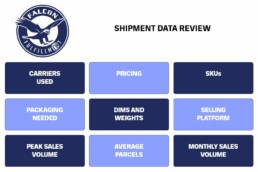
Optimizing Postage and Operations
By analyzing the weights and dimensions of your current packaging, we can optimize your packaging strategy for right-size packaging. Furthermore, we help advise on the most economical and expedited shipping method to fit your current model and SLAs to your customers.
“Data is critical to understanding business, meeting customer demands, and staying ahead of the market. Understanding that data is even more important. That’s why our team thoroughly reviews client data to meet the needs of our partners, their e-commerce, and their customers.”
Lori Denning, Director of Ops
Review Information
At the end of phase two, we evaluate the data and begin our review stage. We consider whether your shipment data meets our partner criteria, whether Falcon can help with your company’s pain points, in what ways we can do so, and lastly, we determine if a partnership is beneficial for both parties.

Phase Three: Bringing in the Teams
If phases one and two appear favorable for both parties we commence with the third phase. This is the point in the onboarding process where we involve the teams who are responsible for fulfillment. This is where we look at the specifics of how the partnership will function practically. The partnership has essentially begun whereby teams meet and lay the groundwork for a long-term and fruitful relationship.
Meet with IT and Operations
Your e-commerce teams will meet with Falcon’s IT and Ops teams. We then coordinate how we connect to the e-commerce shopping channel, pull orders, and ensure the end customers get exactly what they ordered in the timeframe promised.

Phase Four: Review Proposal
At this stage, our teams will be familiarized with one another, and the framework of our partnership will begin to take shape. During phase four, company representatives will reconvene and continue finalizing the details. Final plans will include approval of a tailored pricing model, a custom proposal, and a time to begin onboarding.
Tailored Pricing and Proposal
Fulfillment is not a one-size-fits-all solution. That’s why we provide a comprehensive price and proposal plan tailored to the specific needs of your e-commerce. After reviewing the proposal, answering final questions, and making any necessary modifications, it’s time to set up an official onboarding date and assign your business its own personal account manager to support you every step of the way.

Phase Five: Onboarding
Meet with the Senior Account Manager
The day of onboarding will have finally arrived and a meeting will be arranged between you and the Senior Account Manager to cover all the details. Together, you will be guided through the onboarding process while SKUs are imported, APIs are connected, and your e-commerce is connected to our Shipstream system, among other mission-critical tasks. Your personal account manager will assign a position for your fulfillment. This is contingent on the performance and needs of your e-commerce.
“Account managers act as a direct support line for our clients. Being continually in the loop of sales inventory enables us to reach out and rectify issues before they become problems. Our close relationship with warehouse personnel enables us to communicate with our clients in a timely and easy-to-understand manner. Additionally, we have access to shipping pricing tables and are always looking for new delivery solutions to benefit your e-commerce.”
Falcon Account Manager
Schedule a Start Date
After successfully integrating your selling platforms into our fulfillment software and meeting your new personal account manager, we will be ready to schedule an official start date for your e-commerce. Once we’ve reached this step, the only thing left to do is sit back and relax while Falcon handles the rest.
Celebrate
Although not explicitly in the Falcon onboarding handbook, the current and future success of our partnership is definitely worth a party. When working with Falcon, you gain more time for other important aspects of your business, or maybe more precious time at home with your family. Whatever it is, take the time to celebrate your success. You deserve it.
Beginner’s Guide to Third-Party Logistics (3PL)
The world of e-commerce is always changing, therefore understanding the roll of Third-Party Logistics is integral to keeping up. In light of this our beginner’s guide to third-party logistics (3PL) will delve into the essential aspects, offering insights into fulfillment services, warehousing, and much more.
Read More…
Falcon’s fulfillment process is designed to support you and help you succeed in all aspects of business – especially fulfillment. Working with Falcon, from our streamlined logistics services to our dedicated account managers and an array of networking partners, will provide an advantage to your e-commerce that you will not find anywhere else.
Talk with one of our agents today and get ready to Fly with Falcon.
Let’s Talk!
Scaling Your Subscription Box
Building a Foundation to Scale Your Subscription Box
When it comes to scaling your subscription box, it’s important to create a foundation that allows you to scale your e-commerce business as you please. By revisiting your subscription model and optimizing your shipping strategy, you can begin attracting the customers you need to grow.
Clarify Your Subscription Box Pricing
The first step when scaling your subscription box is to review your pricing model. Is it beneficial for your business and does it allow flexibility to scale?
Consider these two essential numbers:
- Cost of Goods Sold (COGS)
- Profit Margins
By determining the cost of goods sold and your total profit margins, you can create a scalable pricing model for the future that ensures a sustainable profit. Start by determining the lowest price you can charge while still maintaining a profit and the highest price you can charge while still remaining competitive.
Are you worried you can’t afford the perfect subscription box while still providing competitive pricing? Talk with Falcon today and see how we can make your subscription dream possible – and profitable.
Optimize Your Subscription Shipping Strategy
Shipping is one of the biggest unavoidable expenses in e-commerce and it’s important to create a shipping strategy that minimizes costs while still meeting the expectations of customers. By developing a strategy that is flexible to scalability, you ensure your business with a customized plan and support system every step of the way.
Step 1: Outsource or In-house Fulfillment?
There comes a time in every e-commerce journey where in-house fulfillment becomes more challenging than beneficial. Depending on the size of your business, in-house fulfillment may still be an advantage for you to continue utilizing. This is especially true if you haven’t outgrown in-house order fulfillment and costs savings are a priority. However, if you have met your breaking point with in-house fulfillment, it’s time to consider a third-party fulfillment partner. Discuss your options with an agent to see how you can scale by outsourcing your growing fulfillment network.
Step 2: Optimize Packaging for Shipping Requirements
Carefully selecting the packaging materials is imperative to scaling your subscription box model. Determining which size of box will keep products safe while also minimizing size and weight to reduce shipping costs is crucial.
- Utilize packaging with right-size dimensions to keep items packed securely.
- Tightly fill spaces with eco-friendly filler to absorb shock and reduce damages.
- Use lightweight material to minimize overall shipping weight.
Step 3: Bring Fulfillment Locations Closer to Customers
Whether you’re fulfilling in-house or with a dedicated 3PL partner, one fact remains: it costs more to ship farther. That’s why it’s beneficial to partner with a 3PL that has multiple fulfillment locations. Having access to multiple distribution centers cut down on delivery time, shipping costs, and GHG emissions. Furthermore, utilizing multiple locations allows you to offer alternative delivery methods to shoppers such as BOPIS options and local pick-up points.
Attracting Loyal Customers to Scale Your Subscription Model
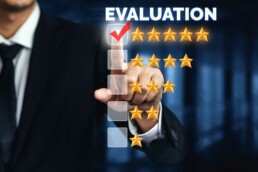
You can prepare your e-commerce to scale in every way but without a dedicated customer base to support your brand, scalability is near impossible. By delivering an attractive and easy shopping experience your target audience, you can retain the support you need to scale.
Compelling Packaging
A unique customer experience is the biggest factor when creating repeat customers out of first-time buyers. Deliver on quality with sustainable packaging, branded elements, and personalized details every shopper will look forward to on a monthly or weekly basis.
Easy to Shop Interface
There is one main aspect to all successful e-commerce websites, and that is interface usability. By providing your customers with a seamless shopping experience, you consequently make it that much easier for them to make a purchase. As a result, customers are more likely to complete transactions and return for future purchases. This is essential when it comes to subscription box models.
Ensure your website performs exceptionally and that the shopping funnel is a streamlined process with easy-to-read information. Additionally, spotlight the unique value of your products with detailed descriptions, realistic photos, and customer reviews. Moreover, include clear pricing that reflects the expectations of your shoppers.
Easy Returns
It’s important to build customer loyalty and assurance by offering a clear and reasonable return process. With hassle-free returns, customers don’t have to worry if it doesn’t fit or if they changed their minds. They want to feel confident in your brand’s ability to exchange products until they’re satisfied. Make sure to advertise your return policy for shoppers to clearly see when entering your online store.
Whether you’re creating a new subscription box or you’re looking to scale, building a flexible foundation is crucial. Once you’ve determined your sweet spot for pricing structure and optimized your shipping strategy for efficiency, you can set a plan in motion to attract the buyers you need to scale your subscription box.
Beginner’s Guide to Third-Party Logistics (3PL)
The world of e-commerce is always changing, therefore understanding the roll of Third-Party Logistics is integral to keeping up. In light of this our beginner’s guide to third-party logistics (3PL) will delve into the essential aspects, offering insights into fulfillment services, warehousing, and much more.
Read More…
Scale Your Subscription Service with Falcon
When you partner with Falcon, scaling your subscription box becomes effortless. Falcon Fulfillment delivers on time-efficient shipping solutions and sustainable packaging materials. Additionally, they offer easy returns and everything you need to scale your subscription service seamlessly and cost-effectively.
Get in touch today and see how we can streamline your fulfillment towards success.
Let’s Talk!
Key Aspects of Creating a Successful Subscription Box
Key Aspects of Creating a Successful Subscription Box
There are key aspects to creating a successful subscription box. Depending on which kind of subscription model your e-commerce business is offering will determine what additional partners you might need. Whether you are considering launching a new subscription box or you are looking to scale, selecting and securing foundational elements is crucial.
Here are a few elements to consider when launching a successful e-commerce subscription box.
What Makes a Successful Subscription Box
Replenishing Need
A successful subscription box consists of something your target customer needs on an ongoing basis. Offering a high-quality consumable product is key to success when developing a subscription model around habitual needs. Depending on your e-commerce niche, there are a variety of products your customers habitually use and would automatically replenish if offered. Here are the main verticals that have seen success within the consumable goods arena.
Beauty and Skin Care
Think shampoos, lotions, body wash, face creams, even sunscreen. All of these items are consumed and therefore need to be replenished regularly. A popular example is Function with Beauty. Once customers complete a quiz to determine which ingredients they need for their personalized hair care, they’re sent customized products every month.

Credit: Function of Beauty
Clothing and Athletic Shoes
Even though high-quality clothing tends to be very durable, things like athletic shoes wear out quickly. If you offer clothing or shoes that need replacing consistently this could be a viable subscription offering. Sneakertub offers a variable subscription box based on time intervals and premium or regular athletic shoes. Regardless, of whether your offering is focused on styling or replenishment, people love to freshen up their wardrobe regularly.

Credit: Sneakertub
Food and Household Goods
Everyone has to eat, but everyone eats differently. The most successful subscription boxes in the food category offer personalization based on diet, location, and even cooking skill level. If you offer a consumable product that is considered a household good, think about how it could be turned into a subscription model. HelloFresh delivers a monthly subscription of ready-to-cook meals anyone can enjoy, taking the guesswork out of dinnertime. Cater to a specific audience in this category to build a successful subscription box revenue stream.
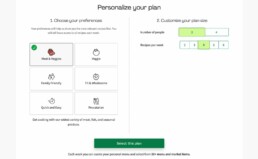
Credit: Hello Fresh
Discovery Value
Have you come across a product or item you wanted to try, but the chance of it being less useful than your go-to product steers you away? With discovery value boxes, shoppers are able to find and experience new products without taking the risk on a new, full-price product.
Ipsy is an excellent example of a discovery value subscription box. Subscribers get monthly products ranging from trending beauty products to household items that TikTok swears by.
It’s important to understand that discovery value boxes target diehard niche shoppers. For instance, customers interested in replenishing their skincare line on a monthly basis aren’t looking for a box full of skincare samples. Contrarily, if your customer happens to be an aesthetician looking to increase their product line, a beauty discovery box might be the exact thing they’re searching for.

Credit: Ipsy
Gifting Potential
Did you know that a large portion of subscription boxes are actually gifted? For example, Kites and Ivy provide a subscription service specifically meant for female college students, but are often purchased by parents and friends. Each box is filled with beauty products, office supplies, and comfort items built just for college. Subscription boxes with gifting potential are an entirely separate category to consider when building your subscription model. Here are a few examples:
Kiwi Crate – A monthly box filled with fun crafts and educational activities for 5 – 8 year-olds.
The Conundrum Box – For all of your crime-junky friends and family, mystery boxes are a great way to surprise them with something that keeps them entertained, and engaged for a longer period of time than a traditional gift box.
Date Night in a Box – This monthly box service acts as both a gift and a treat for yourself. Enjoy various romantic activities with your partner each month with a subscription box both you’re excited to open together.

Credit: KiwiCo
Unique Branded Experiences
Building a successful subscription box includes creating a unique and unforgettable customer experience, but on an automated basis. As we explain in How to Create a Memorable Unboxing Experience, providing that memorable experience for your shoppers is key when setting yourself apart from others and delivering true value to your subscription box.
Here is something to remember when building an experience for an automated subscription box:
Take Credit with Branding
When your customer receives their subscription box and has an unforgettable unboxing experience, don’t let them second guess who is responsible. Personalize everything from the box to the tape with hassle-free fulfillment services or in-house customization to create a branded unboxing experience your shoppers will keep coming back for.

Beginner’s Guide to Third-Party Logistics (3PL)
The world of e-commerce is always changing, therefore understanding the roll of Third-Party Logistics is integral to keeping up. In light of this our beginner’s guide to third-party logistics (3PL) will delve into the essential aspects, offering insights into fulfillment services, warehousing, and much more.
Read More…
Subscription box services are one of the leading e-commerce trends of 2024. By choosing a niche that capitalizes on replenishment needs, delivers a new product experience, or offers a unique gifting potential, you’re able to create a high-value subscription box model that meets the rising expectations of e-commerce consumers.
Are you limiting your subscription box model due to fulfillment efficiency? With Falcon, you can choose the subscription box that’s perfect for you and your shoppers. We can help represent your brand and deliver an unforgettable experience every time. Learn more about how Falcon can help when creating a successful subscription box model.
Let’s Talk!
Returns Management - Outsourcing vs. In-House
Returns Management – Outsourcing vs. In-House
It is essential for product-based businesses to handle returns management effectively. In fact, according to a recent consumer report, 96% of consumers say they would return to a retailer with an “easy” return policy and process. Outsourcing returns management can be a great option to help streamline the returns process and reduce overhead costs. In-House returns management can work for smaller businesses that are not processing a significant amount of returns. This post will discuss good returns management outsourcing vs. in-house.

Elements of Great Returns Management
A good returns management strategy aims to create the most cost-effective and efficient process for both the company and the consumer. Returns management is the process of returning products to the retailer that are defective, no longer needed, or require an exchange. Not only does returns management involve getting goods back to the seller, but it also includes reducing the need for returns altogether.
Essential elements of great returns management include:
- Customer Service – A great returns management process begins with excellent customer service. This includes several key elements, like a clear and easy-to-understand return policy, transparent and prompt communication, as well as various resolution strategies. In addition, if a customer runs into a snag in their return teams or chatbots are readily available to solve more complex return needs.
- Reverse Logistics – Reverse logistics involves every aspect of shipping, tracking, and receiving unwanted products and then processing them accordingly. This includes evaluating the product for damage or repair potential, restocking items, reselling, refurbishing, and shipping out an exchange when required. There are a fair amount of touchpoints during this cycle of the returns management process.
- Inventory Management – Another crucial element of great returns management is inventory management. A recent consumer trend is that customers will buy multiple sizes and colors of a product with the intention of returning them. Therefore, businesses are seeing en masse returns that can affect their bottom line. Every item that can be salvaged must be appropriately repackaged, labeled, and returned to sellable inventory. Alternatively, the stock must be disposed of through the proper channels.

In-House Returns Management
Managing returns in-house can be a blessing and a curse. It can be an excellent fit for new or smaller businesses that are not dealing with a significant amount of returns or exchanges. However, managing returns in-house can become exponentially complicated as a business scales.
Pros of In-House Returns
The main benefits of managing returns in-house involve insight and control over the process. Because teams are completing the returns process directly, the company has full awareness of the efficiencies (or inefficiencies), customer satisfaction levels, and operational impact within the business. Here are a few reasons to consider managing returns in-house:
- Increased control over the returns process
- Improved customer service experience
- Lower costs associated with outsourcing
- Increased insight into customer satisfaction
- Ability to leverage returns data to understand customer preferences and trends better
- Ability to track returns in real-time
- Full transparency into the process
- Improved customer loyalty and retention
Cons of In-House Returns
Complications with in-house returns management start to occur as the number of returns increases. More returns require more staff, customer service hours, and more attention to restocking and inventory levels. Some business owners can get overwhelmed by volume, resulting in a poor customer experience. Here are some of the main drawbacks:
- High labor costs associated with processing returns
- Potential issues with tracking and managing customer data
- Difficulty managing customer expectations
- Difficulty managing inventory and restocking
- Difficulty organizing and tracking shipments
- Increased customer service costs
- Increased risk of customer dissatisfaction

Outsourcing Returns Management
Many businesses find that outsourcing is the best solution to provide high-quality service for their customers. Outsourcing returns management is an excellent way for companies to improve customer service and minimize costs, especially as they grow. In addition, outsourcing can help free up internal resources to focus on the business’s core competencies.
Pros of Outsourcing
Outsourcing releases vital staffing resources for more essential business operations. As a business scales, outsourcing can offset the increased focus that returns management requires. Here are some of the main benefits of outsourcing returns management:
- Cost savings: Outsourcing returns management can reduce labor costs, freeing up resources for other aspects of the business.
- Time savings: By outsourcing returns management, companies can reduce the time spent processing and managing returns. This can significantly improve overall efficiency.
- Automation Technology: Outsourcing returns management can provide companies with improved automation technology. Rather than having to log in to multiple customer management portals, a single point of reference can manage the entire reverse logistics process.
- Improved customer service: Outsourcing returns management can improve customer service by providing customers with a fast and efficient returns process.
- Reduced risk: Outsourcing returns management can help reduce the risk of handling returns internally, such as product damage or lost items.
- Greater expertise: Outsourcing returns management can provide companies with access to greater expertise and knowledge about best practices for returns processing.
Cons of Outsourcing
One of the main things companies worry about when considering outsourcing their returns process is the loss of oversight and control. A genuine concern is losing touch with customers and partnering with a team that will not represent the brand well. Here are some of the drawbacks of outsourcing returns management:
- Increased Cost: Outsourcing returns management can be more expensive than managing returns in-house due to the service provider’s cost./li>
- Loss of Control: By outsourcing returns management, companies lose control over the process and can’t ensure the same level of quality as if the process was managed in-house.
- Loss of Flexibility: Outsourcing returns management can limit companies’ ability to adjust quickly to changes in returns policies or processes.
- Increased Risk: Companies that outsource returns management are at risk of entrusting sensitive customer information to an outside party, which can lead to data breaches or other security issues.
- Lack of Transparency: Companies that outsource returns management may need more visibility into the process and may be unable to track and monitor returns in real-time.
In closing, the returns management process is complicated. Whether you decide to outsource or manage returns in-house, understanding each method’s pros and cons is vital. Evaluate your business needs against the time, resources, and staff you have available to create a seamless returns management process. If your team is overwhelmed, you have received negative feedback, or you cannot restock inventory promptly, it could be time to outsource returns management to a company that specializes in it. Falcon Fulfillment is an expert in eCommerce returns management and can implement brand-specific strategies to meet your growing business needs.
Talk to our agents today if you want to learn more about how we can help you recoup as much of your returns as possible.
Let’s Talk!
How to Scale Past Dropshipping
Scaling Past Dropshipping
Has your business gone from a sweet side-hustle to a 24/7 churn and you need to outsource some operations to regain a life? We just so happen to know a little bit about a key factor in leveling up your e-commerce business. Today we’re going to share how to scale past dropshipping and what steps you can take right now to expand your e-commerce business.
How to Scale Past Dropshipping
Establish Inventory Space
Whether you’re renting warehouse space, investing in property, or clearing out your garage, having a place to put your inventory is the first obstacle you’ll face when working to scale past dropshipping. Where you choose to put your inventory depends on your budget and the number of products you intend to keep on hand. For many, there are three main options:
Renting Warehouse Space
Renting warehouse space from local businesses allows your e-commerce to scale past dropshipping and take full control over inventory.
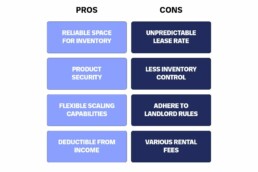
Purchasing Property
Although pricey, if you’re serious about scaling past dropshipping, purchasing your own inventory property might be the most beneficial for mid to larger-sized businesses.
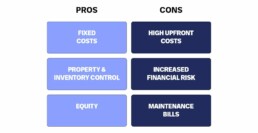
Partner with a Manufacturer
Its common practice to source at least 2 manufacturing suppliers. One oversees and one domestic.
This allows your e-commerce to access lower manufacturing costs while also having a domestic fall-back for any overseas delay. If one manufacturer is good enough for you, consider whether foreign or domestic suppliers would be more beneficial for your e-commerce.
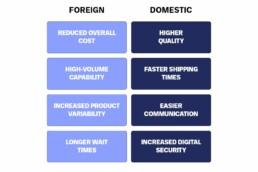
Implement an Inventory Management System
While dropshipping, your inventory was created, fulfilled, and shipped for you. When scaling past dropshipping and transitioning to full inventory control, it’s important to establish an appropriate inventory management system.
Utilizing an IMS for your e-commerce will help inventory be correctly tracked, managed, and stored. This will assist in providing a smooth and hassle-free shopping experience for customers and help create a stress-free environment for yourself and potential employees.
Create Picking, Packing, and Shipping Procedures
Establishing a process for picking, packing, and shipping orders are crucial when providing your own branded experience to shoppers. Whether you’re doing it by yourself or through a fleet of staff, creating a procedure to fulfill orders correctly and in a timely manner is a huge aspect of scaling past dropshipping.
Now, you’re in charge of customer experience. You are the common denominator in receiving orders, packing items, and shipping orders off to create happy customers – how does that responsibility feel?
- Implement an Inventory Management System to keep track of inventory and orders.
- Create a process for how you will pick the correct items.
- Decide on packaging procedure for all orders being sent out.
CRM Software
Amidst all the other obstacles to face when scaling past dropshipping, customer service is a critical aspect. You’re in charge of customer experience from start to finish with no one else to blame when things go wrong.
This means whether your cellphone is buzzing around the clock or you’ve outsourced this to a call center, establishing a Customer Relationship Management Software will help you bypass many customer-related hiccups.
Return Management
Ah, return management. The forgotten sector of business ownership that often brings more stress than reward.
Because of this, creating a proper return management procedure (and policy) will potentially save you thousands of dollars and hours along the way.
Beginner’s Guide to Third-Party Logistics (3PL)
The world of e-commerce is always changing, therefore understanding the roll of Third-Party Logistics is integral to keeping up. In light of this our beginner’s guide to third-party logistics (3PL) will delve into the essential aspects, offering insights into fulfillment services, warehousing, and much more.
Read More…
Fulfill with Falcon
By implementing these suggestions and utilizing warehouse space, manufacturing partners, shipping providers, and fulfillment procedures, you’ll be well on your way to scaling past dropshipping and taking your e-commerce business to new heights.
Make it easy to scale past dropshipping by partnering with Falcon. We can give you all the benefits of personal fulfillment without the investments, risks, and liabilities. Let us help you scale your e-commerce now.
Let’s Talk!
